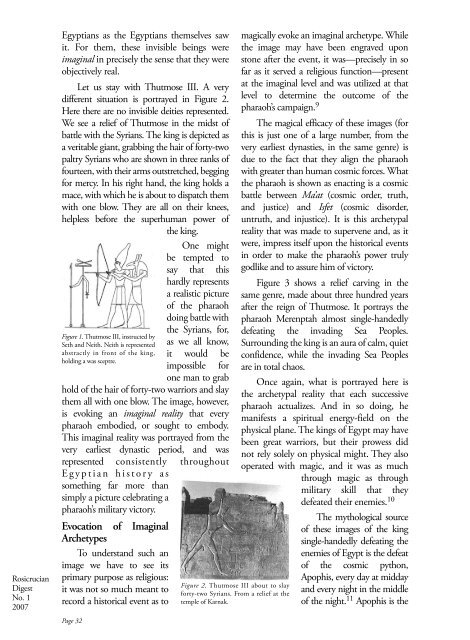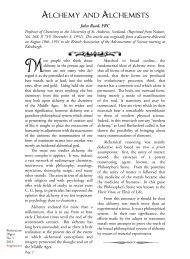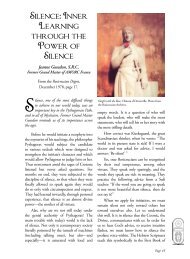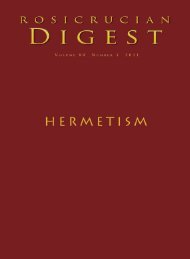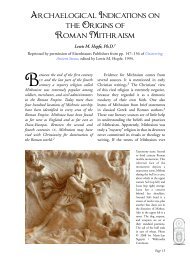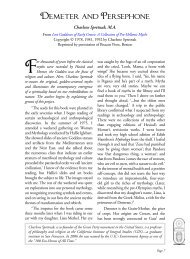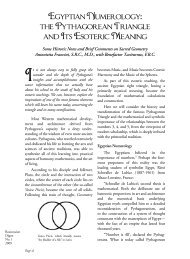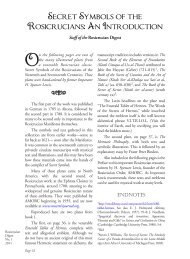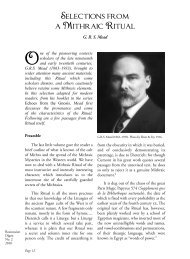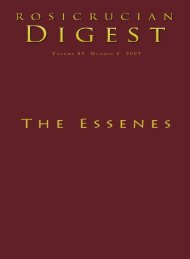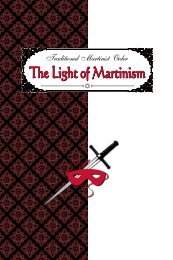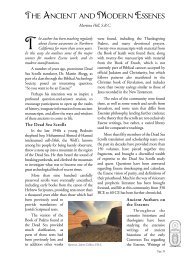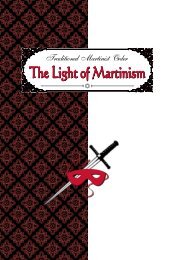Digest - Rosicrucian Order
Digest - Rosicrucian Order
Digest - Rosicrucian Order
Create successful ePaper yourself
Turn your PDF publications into a flip-book with our unique Google optimized e-Paper software.
<strong>Rosicrucian</strong><br />
<strong>Digest</strong><br />
No. 1<br />
2007<br />
Egyptians as the Egyptians themselves saw<br />
it. For them, these invisible beings were<br />
imaginal in precisely the sense that they were<br />
objectively real.<br />
Let us stay with Thutmose III. A very<br />
different situation is portrayed in Figure 2.<br />
Here there are no invisible deities represented.<br />
We see a relief of Thutmose in the midst of<br />
battle with the Syrians. The king is depicted as<br />
a veritable giant, grabbing the hair of forty-two<br />
paltry Syrians who are shown in three ranks of<br />
fourteen, with their arms outstretched, begging<br />
for mercy. In his right hand, the king holds a<br />
mace, with which he is about to dispatch them<br />
with one blow. They are all on their knees,<br />
helpless before the superhuman power of<br />
the king.<br />
One might<br />
be tempted to<br />
say that this<br />
hardly represents<br />
a realistic picture<br />
of the pharaoh<br />
doing battle with<br />
Figure 1. Thutmose III, instructed by<br />
Seth and Neith. Neith is represented<br />
abstractly in front of the king,<br />
holding a was sceptre.<br />
Page 32<br />
the Syrians, for,<br />
as we all know,<br />
it would be<br />
impossible for<br />
one man to grab<br />
hold of the hair of forty-two warriors and slay<br />
them all with one blow. The image, however,<br />
is evoking an imaginal reality that every<br />
pharaoh embodied, or sought to embody.<br />
This imaginal reality was portrayed from the<br />
very earliest dynastic period, and was<br />
represented consistently throughout<br />
E g y p t i a n h i s t o r y a s<br />
something far more than<br />
simply a picture celebrating a<br />
pharaoh’s military victory.<br />
Evocation of Imaginal<br />
Archetypes<br />
To understand such an<br />
image we have to see its<br />
primary purpose as religious:<br />
it was not so much meant to<br />
record a historical event as to<br />
Figure 2. Thutmose III about to slay<br />
forty-two Syrians. From a relief at the<br />
temple of Karnak.<br />
magically evoke an imaginal archetype. While<br />
the image may have been engraved upon<br />
stone after the event, it was—precisely in so<br />
far as it served a religious function—present<br />
at the imaginal level and was utilized at that<br />
level to determine the outcome of the<br />
pharaoh’s campaign. 9<br />
The magical efficacy of these images (for<br />
this is just one of a large number, from the<br />
very earliest dynasties, in the same genre) is<br />
due to the fact that they align the pharaoh<br />
with greater than human cosmic forces. What<br />
the pharaoh is shown as enacting is a cosmic<br />
battle between Ma’at (cosmic order, truth,<br />
and justice) and Isfet (cosmic disorder,<br />
untruth, and injustice). It is this archetypal<br />
reality that was made to supervene and, as it<br />
were, impress itself upon the historical events<br />
in order to make the pharaoh’s power truly<br />
godlike and to assure him of victory.<br />
Figure 3 shows a relief carving in the<br />
same genre, made about three hundred years<br />
after the reign of Thutmose. It portrays the<br />
pharaoh Merenptah almost single-handedly<br />
defeating the invading Sea Peoples.<br />
Surrounding the king is an aura of calm, quiet<br />
confidence, while the invading Sea Peoples<br />
are in total chaos.<br />
Once again, what is portrayed here is<br />
the archetypal reality that each successive<br />
pharaoh actualizes. And in so doing, he<br />
manifests a spiritual energy-field on the<br />
physical plane. The kings of Egypt may have<br />
been great warriors, but their prowess did<br />
not rely solely on physical might. They also<br />
operated with magic, and it was as much<br />
through magic as through<br />
military skill that they<br />
defeated their enemies. 10<br />
The mythological source<br />
of these images of the king<br />
single-handedly defeating the<br />
enemies of Egypt is the defeat<br />
of the cosmic python,<br />
Apophis, every day at midday<br />
and every night in the middle<br />
of the night. 11 Apophis is the


